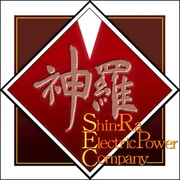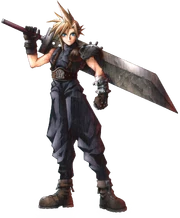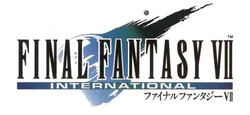Template:Sideicon Template:Sideicon
Template:Infobox CVG Final Fantasy VII is the seventh installment in the Final Fantasy series, released in 1997 by Square Co., Ltd., and continues to be one of the most popular games in the series. It was directed by Yoshinori Kitase, written by Kitase and Kazushige Nojima, and produced by Hironobu Sakaguchi. It was the first game of the Final Fantasy series to be developed for the PlayStation rather than a Nintendo system, and the first game in the series to be ported to Windows. Final Fantasy VII was the first Final Fantasy title with entirely 3D (polygonal) character models, although the majority of environments were two-dimensional pre-rendered maps (except the world map and battle screens, which were rendered in full 3D).
Final Fantasy VII is one of the best-selling games of all time, with the highest sales (over 11 million copies[1]) of any game in the Final Fantasy series, and the second highest sales for a game on the PlayStation platform. It received GameSpot's Editor's Choice, scoring a 9.5/10 and a 9.6/10 user score. Since its debut on the Sony PlayStation, Final Fantasy VII has been released on the PC and the PlayStation Network. It is widely considered one of the most influential RPGs to-date.
Unlike Final Fantasy IV and Final Fantasy VI, which in North America were renamed II and III (II, III, and V were not yet released internationally at that time), Final Fantasy VII retained the number seven for its westernized release. The game has spawned a sub-series of sequels, prequels, and "midquels" called the Compilation of Final Fantasy VII.
On June 15 during E3 2015 it was announced Final Fantasy VII will be remade and come first to PlayStation 4, other platforms TBA.
Gameplay
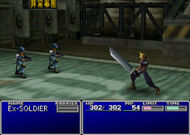
The first battle in Final Fantasy VII.
Final Fantasy VII is a menu-driven role-playing game. Initially, the player is restricted to the city of Midgar, but as the game progresses, more of the world becomes accessible, and the scripted adventure sequences give way to greater freedom and opportunities to explore. At several points, the game is interrupted by scripted dramatic sequences, some of which are lengthy.
During its turn-based battle sequences, the game uses the same Active Time Battle (ATB) system utilized in the three Final Fantasy games preceding it. Unlike previous games in the series, which traditionally allowed for a maximum of four to five party members to participate in battle, Final Fantasy VII allows for only three characters at any one time.
The Final Fantasy VII skill system utilizes Materia, magic orbs which can be placed in slots on weapons and armor. Materia allows characters to access magic spells, command abilities, and a variety of passive abilities. Materia can be combined in a fixed number of ways, and strategic use of the combinations allows various tactics suiting different play styles.
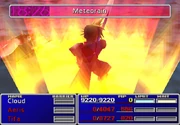
Cloud Strife charging his Limit Break, Meteorain.
A feature introduced in Final Fantasy VI, the "desperation attack" returns in Final Fantasy VII in a new, modified form now known as the Limit Break. Every playable character has a "limit bar" which fills up proportionally to the damage received by the character in battle. When the limit bar is filled one can unleash a Limit Break, a special ability which generally inflicts much more damage on an enemy than normal physical attacks; some Limit Breaks target all the enemies on the field, and other Limit Breaks support the party, healing HP or providing status buffs.
Final Fantasy VII popularized the inclusion of difficult optional bosses to offer reward and challenge. A series of strong monsters called Weapons appear, and the player must confront several of them throughout the plot, but two of them—Ruby Weapon and Emerald Weapon—can only be encountered if the player goes above and beyond to find them. These two bosses were not included in the original Japanese version of Final Fantasy VII; they were added to the European and American versions.
Setting
An energy manufacturing mega-company known as Shinra, Inc. is harvesting the sheer life energy of the Planet (known as the Lifestream) as a simple fossil fuel. The Lifestream is processed and made into products ranging from electricity and heat to Mako and Materia. The latter two materials can work miracles, granting the wisdom of the Ancients to the user. However, the Lifestream, like most other fuels, is finite in supply, and the Planet's lifeforce is being malevolently drained by the constant exploitation of Mako by Shinra. Though aware of the harmful effects, they function without remorse.
However, the real battle lies not with a corporation, but a force much more competent from the distant past. A long-thought dead warrior bent on becoming a god by draining all of the Lifestream from the Planet has risen again and will stop at nothing to achieve his goal.
Now a small rebel group emanating from the slums must quell the various dangers toward the innocent, and one mercenary for hire must look amidst the lies and deception and find the man he is within.Official Introduction
Gaia, referred to as the Planet by the people of the world, is a technologically advanced planet dominated by humans, who are the only major sentient race other than a few nearly extinct species. The world is economically, militarily, and politically dominated by the powerful conglomerate of Shinra Electric Power Company, which profits from the use of Mako Reactors.
The reactors siphon a special type of energy—called "Mako"—out of the Planet and convert it into electricity. One of the byproducts of the extraction and refinement of Mako energy is Materia, a concentrated form of Mako which allows the wielder to harness its magical properties. President Shinra leads his eponymous organization, and is the world's de facto ruler. Unbeknown to most of the world Shinra is involved with many horrible genetic experiments, which have created many of the monsters that roam the Planet.
Mako energy is drawn from the Lifestream, a flow of life-force beneath the Planet's surface. All life originates from the Lifestream, and returns to it upon death and the Lifestream is the sum of all the life that has ever and will ever live upon the Planet. The process of extracting Mako energy drains the life of the Planet to generate electricity. This can be seen in the Shinra's capital city of Midgar surrounded by a wasteland where plants barely grow.
Characters
The main playable characters in Final Fantasy VII are:
- Cloud Strife is the main protagonist, posing as a former member of SOLDIER now operating as a mercenary caught up in the actions of eco-terrorist group AVALANCHE. Uncaring and cold at first, he begins to change when he begins to discover his shrouded past.
- Barret Wallace, the leader of AVALANCHE, wields a gun on his right arm in place of his injured hand. Despite his brash and loud-mouthed personality, he is a caring person and loves his daughter Marlene.
- Tifa Lockhart, Cloud's childhood friend and member of AVALANCHE, runs the bar 7th Heaven in the Sector 7 slums, which serves as the group's hideout. Her sympathetic exterior hides fearsome fighting skills.
- Aeris Gainsborough, a flower girl from the Sector 5 slums and the last of the Cetra, was captured by Shinra at a young age but escaped with her mother Ifalna, who died, leaving Aeris orphaned. Aeris was found and raised by Elmyra Gainsborough.
- Red XIII is a quadrupedal, flame red beast capable of speech. The party rescues him from capture and attempted breeding at Shinra Headquarters. He speaks little, but when he does, his words are often important.
- Cait Sith, a robotic cat atop a stuffed Mog, operates as a fortune teller when the party meets him at the Gold Saucer. He shouts commands to his Mog in battle using a big megaphone. His friendly attitude belies a darker side, but he is eventually used for good.
- Cid Highwind, the foul-mouthed, chain-smoking pilot of Rocket Town dreams of being the first man in space. He was forced to abort the mission after his assistant, Shera, was running a safety check on the rocket and would have burned to death had it taken off. Despite his bitter attitude, Cid has a good heart and cares about his friends.
- Optional Characters
- Yuffie Kisaragi, first encountered as the Mystery Ninja, can be encountered in any forest after the events at the Mythril Mine. A self-professed Materia hunter, she is sneaky and playful, and 'hunts' Materia to restore her home of Wutai to its former glory.
- Vincent Valentine, discovered sleeping in a coffin by the party at Shinra Mansion in Nibelheim, is a former Turk with a traumatic past. After being subjected to numerous experiments, Vincent became able to transform into monstrous forms, but sealed himself in the coffin because of guilt in his past. Like Red XIII, he speaks little but offers helpful advice when he does.
- Guest
- Sephiroth, is an non-controllable temporary party member during a single sequence. After resurfacing years after being deemed dead, pursuing Sephiroth becomes the party's main motivation.
Story
AVALANCHE
Within the Midgar Slums resides the eco-terrorist organization AVALANCHE led by Barret Wallace, a former denizen of Corel, a town destroyed by the Shinra Corporation. AVALANCHE hires a mercenary named Cloud Strife, who claims to be a former member of Shinra's elite special forces team, SOLDIER.
Cloud is plagued by psychic disturbances, and at first shows little interest in AVALANCHE's cause; by his own admission, he is only interested in money. Other members include Cloud's childhood friend, Tifa Lockhart, whom Cloud made a promise to protect back before he left their hometown of Nibelheim to join SOLDIER, and Jessie, Biggs and Wedge.
AVALANCHE's mission is to blow up the eight Mako Reactors that ring the city. During a mission Cloud is separated and meets Aeris Gainsborough in the slums. To counter AVALANCHE's attacks, Shinra drops a portion of Midgar's upper plate upon the Sector 7 slums to destroy their base, killing Jessie, Biggs and Wedge, and most of the people of Sector 7. Shinra captures Aeris and takes her to their headquarters.
Shinra's management is concerned with the limited repositories of Mako energy available for harvesting, and fascinated with the legend of the Promised Land; a place of legend where Mako flows abundantly. Only a race called the Cetra, also known as the Ancients, are, according to legend, able to find it. The Cetra were all but driven to extinction by the "Calamity From the Skies" 2000 years ago, and Aeris Gainsborough is their only survivor, whom Shinra has been trying to capture for years.
Cloud and the remains of AVALANCHE storm the building to rescue Aeris from Professor Hojo's lab, where Cloud spots a headless creature called Jenova kept in a tank, and reacts to it, though he cannot explain his experience to the others. They find Hojo has caged Aeris with Red XIII, one of his other test subjects, and free them, but end up captured themselves. As the tank where Red XIII and Aeris were kept was broken, everyone is sent into prison cells within the building.
The group is freed from their cells by the surprise reappearance of the supposedly dead legendary SOLDIER, Sephiroth, following the escape of a headless Jenova from her tank. President Shinra is killed during Sephiroth's return, and the young and ruthless Rufus Shinra takes the company's reins. Cloud and his party make a hair-thin escape from Midgar by fighting their way through the ranks of Shinra forces.
Chasing Sephiroth
Cloud decides to hunt down Sephiroth to avenge the destruction of his hometown, and the others follow suit. Tifa shares Cloud's hatred for Sephiroth and wants to keep an eye on Cloud as his unstable behavior troubles her. President Shinra had told Aeris Sephiroth is an Ancient, and she wants to seek him out to discover more of her heritage. Red XIII decides to accompany the others until he can return home in Cosmo Canyon.
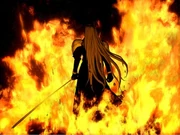
Sephiroth, silhouetted by the flames of Nibelheim.
In the town of Kalm Cloud tells the others his tale of the Nibelheim Incident, or what happened in the town five years ago, but his story is filled with gaps. Cloud tells that five years ago he and Sephiroth had been sent to Cloud's hometown to investigate the local Mako Reactor where Sephiroth had found Jenova, a creature Shinra took to be an Ancient, and who had been called Sephiroth's mother. Troubled by the discovery, Sephiroth had delved into his past and the Jenova Project—from which he was born—led by Professor Gast and the deranged Professor Hojo. His findings had driven him insane and, believing himself to be the last Ancient, Sephiroth had taken revenge on humanity by burning Nibelheim to the ground. Cloud's mother and Tifa's father had perished during the incident, and a furious Cloud had set out to confront Sephiroth, but his recollection fails before he can reach the end of the story.
After hearing of a man in a black cape the group follows the rumors to Junon where they are surprised to find Rufus Shinra holding his crowning ceremony. The party disguises as crew members and stows away on the cargo ship bound for the western continent. Sephiroth appears on the ship and kills almost every crew member. Cloud and his party locate him as he materializes out of the floor, but Sephiroth doesn't recognize Cloud. Cloud attempts to get answers on Sephiroth's goal, but end up battling Jenova∙BIRTH, a monster made out of parts of Jenova.
The party pursues Sephiroth across the Planet, but they do not search alone, as Rufus also wants to take Sephiroth in and has dispatched the Turks, a group of Shinra special operatives, to carry out the task. The party runs into the Turks several times, and in Gold Saucer they meet Cait Sith, a fortune teller cat robot, who joins them. Barret must confront his past as they return to the site of his former home town, and in Cosmo Canyon Red XIII intends to leave the party, but changes his mind upon discovering the truth of his father whom he had thought cowardly, resolving to protect the Planet by continuing to travel with Cloud and his friends. Cosmo Canyon is a center of study on the Planet and its Lifestream, and Aeris speaks with the elders and deduces Sephiroth is not an Ancient, and that she is the only Cetra left.
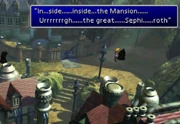
A Sephiroth Clone in the restored Nibelheim.
The group keeps pursuing the rumors of a man in a black cape and arrives at Nibelheim, finding it fully rebuilt by Shinra and populated by Shinra employees posing as the villagers to cover up the incident five years ago. The town is infested with people robed in black who rant on about Sephiroth, the numbered Sephiroth Clones Professor Hojo had created after Nibelheim's torching to test his Reunion theory. The party finds Sephiroth himself at the library of the Shinra Manor who asks for Cloud to join him in the Reunion, but Cloud doesn't know what he is talking about.
Sephiroth flees and the group chases him across the Mt. Nibel to Rocket Town where they meet Cid Highwind, an aeronautical engineer whose dreams of going into space had been dashed by Shinra's lack of funding. Rufus arrives to take Cid's airplane, the Tiny Bronco. Cid refuses, and the party helps stop Palmer, a Shinra executive, from stealing the plane, but end up boarding it themselves along with Cid, who joins the party. The plane crashes into the ocean and becomes the party's boat.
Vincent is a former Turk who was betrayed by his love, Lucrecia Crescent, Sephiroth's biological mother and a Shinra scientist, and turned into a monster. He sleeps beneath the Shinra Mansion in Nibelheim in penance for his sins of failing to stop the Jenova Project, but joins the party upon learning they might run into Professor Hojo whom he deems culpable for everything. Yuffie is a girl from Wutai Village, a town that fought Shinra dominance during the Wutai War, but has since capitulated. She dreams of restoring her homeland's pride, and joins the party to achieve that.
The party's pursuit of Sephiroth leads them to discover several things. Sephiroth's plan is to use the Black Materia, a Materia so powerful the Cetra hid it away that contains the spell Meteor, the ultimate Black Magic that summons a meteorite to crash into the Planet. Sephiroth's plan is to create a wound in the Planet so large the Lifestream will be sent en mass to heal it where Sephiroth would intercept it and take control of the world.
Sephiroth is followed by a group of black-robed fanatics, the Sephiroth Clones, all bearing a tattoo somewhere on their bodies placed by Professor Hojo. Despite called "clones" they are not true clones however, but normal people Hojo had injected with Jenova's cells.
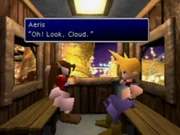
Cloud on a date with Aeris.
Cloud's party grabs the Keystone required to open the Temple of the Ancients from Dio, Gold Saucer's owner. During their stay at the amusement park Cloud goes on a date with a fellow party member and Cait Sith steals the Keystone and hands it over to Tseng, the leader of the Turks, revealing himself a Shinra spy sent to infiltrate Cloud's group. Cait Sith refuses to reveal his true identity and blackmails the others to take him along.
Tseng and his fellow Turk Elena use the Keystone to access the Temple of the Ancients, but cannot decipher its murals. As Elena departs to report to Shinra, Sephiroth attacks Tseng. Cloud and his party find a wounded Tseng as they arrive at the temple, and regain the Keystone and use it to get deeper into the maze. It turns out the temple itself is the Black Materia, and to make into a usable form, somebody must be left inside while the temple shrinks. Cait Sith volunteers, his body being a robot, and he is destroyed once the temple turns into a Materia sphere.
Cloud takes the Black Materia but Sephiroth arrives and bends Cloud under his control. Cloud hands the Materia over to Sephiroth and attacks Aeris, and is knocked out by the other party members. Another Cait Sith appears to replace the first, and Aeris leaves the party to find a way to save the world from Meteor now that Sephiroth has acquired the Black Materia.
Aeris travels to the Forgotten Capital, the lost city of the Cetra. Cloud is troubled Sephiroth was able to control him but resolves to continue his journey as Tifa and Barret encourage him to go on. The party chases after Aeris and Sephiroth and when they find her praying on an altar at the Forgotten Capital Cloud is almost bought to kill her by Sephiroth's control, only being snapped out of his thrall by the intervention of his comrades.
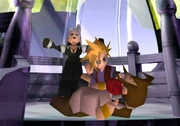
Cloud mourns for Aeris while Sephiroth gloats.
Sephiroth murders Aeris by impaling her with the Masamune. Cloud is enraged but Sephiroth taunts Cloud, telling him he should not act as though he has feelings. Floating up into the sky, the "Sephiroth" turns out to be Jenova; the person the party hunted and followed since the beginning was Jenova—escaped from the tank in the Shinra Headquarters—taking Sephiroth's form. After a battle with a piece of Jenova, the party pays their respects to the departed Aeris as Cloud lays her deceased body to rest in the waters of the Forgotten Capital. Cloud decides to continue on the journey to complete his revenge against Sephiroth even knowing he may lose control of himself again.
In Icicle Inn the party finds recordings that detail Aeris's birth and Jenova's true nature, as that is where Aeris was born to Gast Faremis and Ifalna. Gast was the scientist who had led Shinra's Jenova Project who had departed the company upon finding a true Cetra, Ifalna, the last survivor. Gast had helped Ifalna escape Shinra and the two had settled in the remote Icicle Inn where Gast had interviewed her on her knowledge on Jenova and the guardians of the Planet, Weapons.
Ifalna had told Gast Jenova, which Gast had mistaken as a Cetra, was in fact the "Calamity from the Skies" responsible for the Cetra's dwindled numbers, as Jenova is a shapeshifting extraterrestrial organism that had arrived on a meteorite 2000 years ago, creating the large crater to the Planet's north pole. The creature had been sealed away by the last surviving Cetra, and it was from this geological stratum that Gast and his researchers had excavated its body 2000 years later. When Hojo had discovered Gast and Ifalna's hideout he had killed Gast and taken Ifalna and baby Aeris captive. The two had later escaped into the Midgar slums, but Ifalna had perished during the escape and Aeris had been adopted by a slum dweller.
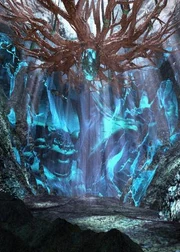
North Crater.
The party follows Sephiroth to the North Crater that had been created by Jenova's fall two thousand years ago. They are joined by Rufus and his gang, arriving on the airship Highwind, and a horde of Sephiroth Clones, all of whom Sephiroth slays. After catching up to "Sephiroth" he transforms into Jenova∙DEATH, and after defeating it the party reclaims the Black Materia. Cloud explains to the others that what they had been pursuing was not the true Sephiroth, but can feel he is nearby. Cloud and Tifa go alone, and Cloud hands the Black Materia to a party member remaining behind to prevent himself from being tricked into giving it to Sephiroth again.
Cloud and Tifa stumble upon an illusion of the events that took place in Nibelheim five years ago and Sephiroth shows Cloud was never there, his role taken by a man called Zack. Tifa cannot refute Sephiroth's claims, and Cloud begins to believe they are true. Sephiroth claims Cloud is but a facsimile created by Hojo, a puppet with false memories posing as a boy "Cloud" Tifa knows from her childhood. Sephiroth creates another illusion to trick the party member holding the Black Materia to come to Cloud, who takes the Materia and explains to his friends he is a mere pawn for Sephiroth, yet another Sephiroth Clone. Hojo, who has accompanied Rufus to the crater, is at first interested in Cloud, but upon discovering Cloud doesn't have a numbered tattoo, discards him as a failure, annoyed a "failed experiment" is the only one to have made it to the "Reunion" with the true Sephiroth.
Sephiroth's true body emerges from a Materia cocoon, and Cloud hands him the Black Materia. Sephiroth summons the Meteor, which awakens the Planet's guardians, the Weapons, giant monsters of immense destructive power. As the crater floor crumbles Cloud and Sephiroth's cocoon fall into the Lifestream and the party escapes with Shinra on their airship, the Highwind. Tifa is knocked unconscious and Barret is caught as he tries to take her away, both taken to Junon while the rest of AVALANCHE escapes on their own.
Meteor Falls
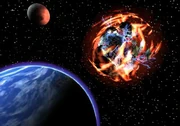
Meteor looms over the Planet.
While unconscious Tifa hallucinates chasing Cloud who disappears into darkness, and recalls how she met him on the Sector 7 slums train station some time before he was hired into AVALANCHE. Cloud had been acting strange and claimed it had been five years since they'd last seen. Although Tifa knew it to be longer than that, she had never confronted him, instead asking him to join AVALANCHE so she would have more time to decide what to do and to keep an eye on him and his strange behavior.
Tifa awakes in Junon seven days later and finds a world in chaos; a meteorite looms over the sky, a sign of the impending end of the world. Sephiroth has surrounded the North Crater with a barrier preventing either Shinra or the Weapons from attacking his true body, and the creatures have taken to attacking Shinra's sites of power instead. Rufus, trying to show Shinra is still in control, decides to use Tifa and Barret as scapegoats and publicly execute the pair on live broadcast TV. Before the execution can go through, Sapphire Weapon attacks Junon, and Shinra kills it with a direct shot to the face with the Mako Cannon. The other party members, led by Cait Sith, sneak in during the attack to rescue Tifa and Barret, and steal the Highwind.
The party finds Cloud suffering severe Mako poisoning in the town of Mideel, where he had washed in by the currents of the Lifestream, an ethereal substance that streams beneath the surface of the Planet that is the Planet's life energy. Tifa stays behind to watch over him, as she is adamant Sephiroth's story of Cloud being Hojo's creation with false memories is untrue, and wants to help him regain his true self. Cid leads the party to claim Shinra's Huge Materia, which Shinra schemes to load onto Cid's rocket and launch directly at the meteorite. Cid doesn't want Shinra to get their hands on the Huge Materia, and wants them for their own use to fight against Sephiroth.
The Ultimate Weapon crashes in Mideel. The town is destroyed by an earthquake as the Lifestream swallows it and Cloud and Tifa fall in. Being submerged in the Lifestream allows Tifa to travel inside Cloud's Subconscious and sort through his true memories and secret desires, such as joining SOLDIER in part to gain Tifa's attention. She confirms Cloud is the genuine article, although not the person he had made himself believe he was.
Cloud recalls the true past.
Cloud had never made it into SOLDIER and had become a lowly Shinra infantryman instead. Embarrassed by his failure, he had not told anyone from his hometown. When he had been assigned a mission in Nibelheim to accompany the SOLDIER members Zack and Sephiroth, Cloud had concealed his identity by always wearing his helmet, and this is why Tifa had not realized Cloud was there at the time. After Sephiroth had learned Shinra had created him from Jenova, he had gone insane and torched the town. Sephiroth had departed for the Mako Reactor to save his "mother", as Jenova was being contained there. Zack had confronted Sephiroth at the reactor, but lost. Cloud had arrived soon after seeking revenge, and a weakened Zack had given Cloud his Buster Sword to kill Sephiroth with. Cloud had hurled Sephiroth into the Lifestream below the reactor, but had suffered great wounds in the affair and fallen unconscious.
After Hojo had arrived to assess the situation, he had taken Zack and Cloud, as well as the other survivors from the village, to be his test subjects to turn them into Sephiroth Clones by injecting them with Jenova cells. While the villagers had been turned into clones, Zack and Cloud had not reacted as desired, and were deemed failures to be contained in the Shinra Manor. Cloud's mind had been shattered by the trauma of the events and as a result of Hojo's experimentation and he had merged his ideal self with Zack and Tifa's memories, and replaced Zack with himself in his recollections.
After Cloud had hurled Sephiroth into the Mako pit below the reactor, Sephiroth's body had dissolved into the Lifestream, but his consciousness had been strong enough to remain intact. Sephiroth had thus learned the wisdom of the Cetra from the Lifestream, and begun to construct a new body for himself inside a Materia cocoon at the North Crater. He had taken over the remains of Jenova at the Shinra Headquarters, morphed it into his image, and used it to bring the Black Materia to his true body to summon Meteor.
As Cloud and Tifa are rescued from the Lifestream the restored Cloud returns to lead the party, revealing to the others he is not an ex-SOLDIER, as he had not been mentally strong enough to qualify. If he returns to the Nibelheim Mansion, Cloud recalls how he and Zack had escaped. After being held captive for many years in the Shinra Manor, Zack had broken free, and taken Cloud along as they had escaped the restored Nibelheim, giving Cloud an old SOLDIER First Class uniform to wear.
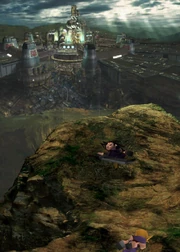
Cloud and Zack's body on the precipice overlooking Midgar.
Shinra had caught up with the pair on a precipice overlooking the Midgar Wasteland and Zack had been gunned down, but the soldiers had ignored the catatonic Cloud and left him for dead. Cloud had crawled over to Zack's body and taken his Buster Sword, then made his way to Midgar alone where he had wandered aimlessly before being discovered by Tifa at the Sector 7 slums train station. At the sight of her Cloud had snapped out of his stupor and made up a new persona as a former SOLDIER First Class to gain a sense of identity and to cover up the gaps in his memory.
Upon hearing the party has been hunting the Huge Materia Cloud joins the fray. When they storm the launch of Cid's rocket they end up trapped inside as it takes off. Cid discovers he had been wrong in admonishing his assistant Shera for ruining his dreams of space flight, and the party returns to the Planet on an escape pod. The rocket fails to destroy the meteorite, and as the party gazes at their world from outer space they reaffirm their conviction to protect it, and decide to uncover what Aeris's plan to stop the Meteor had been.
With help of the Cosmo Canyon elder Bugenhagen, the party discovers the reason Aeris had gone off alone to the Forgotten Capital. Aeris had planned to summon Holy, the ultimate White Magic and a counter to Meteor, using the White Materia that had been passed down in the Cetra lineage and she, as the last Cetra, had possessed it. Just before her death her prayer had reached the Planet, but Sephiroth is holding back the power of Holy within the Planet Core.
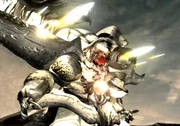
Diamond Weapon fires at Midgar.
Diamond Weapon rises out of the sea and charges towards Midgar. Rufus and the Shinra Executives have moved the Mako Cannon to Midgar and renamed it Sister Ray to prepare for an offensive against Sephiroth. The cannon destroys the Weapon, and the blast reaches North Crater, breaking Sephiroth's shield. Before dying the Weapon fires out energy blasts into the Shinra Building, seemingly killing Rufus and creating a power vacuum at the top of his organization. Midgar falls into chaos. Cait Sith pleads for Cloud and his friends' help, and ends up revealing his true identity as that of Reeve Tuesti, a Shinra executive in charge of Midgar.
Cloud's party infiltrates the city to fight Hojo who has taken command of the Sister Ray and is trying to re-launch it despite it obliterating Midgar. They fight their way through the remaining forces of Shinra to reach Hojo who reveals he wishes to give his son a boost from the Sister Ray's power; the party learns Hojo is Sephiroth's father and thus directly responsible for the crisis facing the Planet. Despite the power he has gained by injecting himself with Jenova cells, Hojo is defeated.
With only a week until Meteorfall Cloud asks everyone to come up with their own reason and resolve to keep on fighting, beyond the mere reason of fighting for the Planet; should they find one, they may return for the last battle. Cloud and Tifa have nowhere to go and spend the night together under the stars. The next morning the others return and Cloud thanks them. Reminded of Aeris's hope and smile even in the face of death, the party is driven to ensure her deeds aren't wasted.
The party ventures to the depths of the Northern Cave, and in the Planet Core finds Sephiroth, blocking Holy from being released. The team triumphs over Bizarro∙Sephiroth, and then Safer∙Sephiroth, a half-human, half-divine form befitting Sephiroth's vision of becoming a god. Despite Sephiroth's immense power, he is defeated.

The fall of Meteor.
When party begins to depart Cloud collapses, his spirit being torn from him to mentally defeat Sephiroth within the Lifestream, freeing Cloud of the mental chains to his enemy. The victory comes too late, and when Holy is released Meteor has fallen too far for Holy to unleash its full power. Midgar is destroyed in the struggle between Meteor and Holy, but Aeris's spirit commands the Lifestream to congregate and push Meteor far enough away from the Planet for Holy to destroy it.
500 years later Red XIII and two pups arrive on a precipice over the overgrown ruins of Midgar with children's laughter ringing in the background.
Music
The soundtrack was Nobuo Uematsu's 22nd work for Square. Music from the game has been commercially released on an original four-disc soundtrack, a single disc album of selected arranged tracks titled Final Fantasy VII: Reunion Tracks, and piano-only arrangement of selected tracks, the Piano Collections: Final Fantasy VII.
Popular pieces from the production include "Aerith's Theme", a subdued and melodic character anthem, and "One-Winged Angel", the first composition for the series to utilize recorded voices. The "Main Theme of Final Fantasy VII", heard on the world map in disc 1, is over six minutes long. Several tracks from the game have resurfaced in subsequent Square (and Square Enix) productions, including Kingdom Hearts and Final Fantasy VII: Advent Children.
At the time, the soundtrack for Final Fantasy VII was considered Uematsu's most ambitious. As a result of time constraints and the limited storage space afforded to him, Uematsu opted to utilize a high-quality midi format. This was at a time when digital and Redbook audio were coming into their own, and some worried the game's soundtrack would suffer as a consequence. These fears proved unrealized, as the score of Final Fantasy VII is often ranked among the most popular and memorable in the series.
Nobuo Uematsu will not return for the remake[2]; it is still unknown who will compose/arrange the music for it.
Development
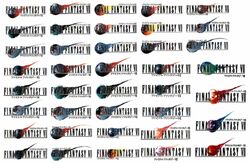
Logo sketches.
Planning sessions for Final Fantasy VII began in 1994 after the release of Final Fantasy VI. At the time, Final Fantasy VII was planned to be another 2D project for the Super Nintendo Entertainment System.[3]
Series creator Hironobu Sakaguchi has noted the game's central theme of "life" dating back to when his mother passed away while he was working on Final Fantasy III (uncertain whether the interview is referring to Final Fantasy III or Final Fantasy VI), after which he always wanted to explore the theme of "life" in a "mathematical and logical way to overcome the mental shock."[4]
Sakaguchi intended the story to take place in modern New York City in the year 1999. Several of the staff were working in parallel on Chrono Trigger, and development for Final Fantasy VII was interrupted when the other project became significant enough to require the help of Yoshinori Kitase and other designers. Some of the ideas originally considered for Final Fantasy VII ended up in Chrono Trigger and other ideas, such as the New York setting and the sorceress character Edea, were kept unused until the later projects Parasite Eve and Final Fantasy VIII respectively.
Development of Final Fantasy VII resumed in late 1995, and required the efforts of approximately 120 artists and programmers, using PowerAnimator and Softimage|3D software.[5] This was the largest game development team at the time, and included Japanese CG artists working alongside Hollywood CG visual effects artists, such as Ron Sabatino, former British ILM artist Paul Ashdown who worked on Star Wars and Jurassic Park, and artists from Digital Domain who worked on Terminator 2 and True Lies.[6] Final Fantasy VII was the most expensive video game of its time, with a production budget of around US$45 million,[7] equivalent to $67 million in 2015.[8]
Aside from the story, Final Fantasy VI had many details undecided when development began with many things filled out along the way. In contrast, with Final Fantasy VII the developers knew from the outset it was going to be "a real 3D game," so from the earliest planning stage detailed designs were drawn up. The script was also locked in, and the image for the graphics was fleshed out. So when the actual work began "storyboards" for the game were already in place.[9]
Hardware
The co-director and scenario writer of Final Fantasy VI, Yoshinori Kitase, returned to direct and co-write Final Fantasy VII and was concerned the franchise might be left behind if it did not catch up to the 3D computer graphics used in other games at the time. Production began after the making of a short, experimental tech demo called "Final Fantasy SGI" for Silicon Graphics, Inc. Onyx workstations. The demo featured polygon-based 3D renderings of characters from Final Fantasy VI in a real time battle. This experiment led the development team to integrate these design mechanics into Final Fantasy VII.[9] It was unveiled in August 1995 at the SIGGRAPH show, where many incorrectly assumed it to be for the Nintendo 64.[10]
When we discussed designing the field scenes as illustrations or CG based, we came up with the idea to eliminate the connection between movies and the fields. Without using blackout at all, and maintaining quality at the same time, we would make the movie stop at one cut and make the characters move around on it. We tried to make it controllable even during the movies. As a result of using a lot of motion data + CG effects and in still images, it turned out to be a mega capacity game, and therefore we had to choose CD-ROM as our media. It other words, we became too aggressive, and got ourselves into trouble.
Hironobu Sakaguchi[11]
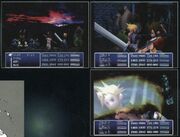
Early battle concept.
As a result of the high quantity of memory storage required to implement the motion data for characters, only the CD-ROM format would be able to suit the project's needs. Nintendo, for which Square had developed all previous titles in the Final Fantasy series, had decided to continue using cartridges for its upcoming Nintendo 64 console, which led to a dispute that resulted in Square ending its long relationship with Nintendo. Square announced on January 12, 1996 it would be developing Final Fantasy VII for Sony's PlayStation platform.
Another reason for choosing the CD-ROM was related to price. One of the big reasons the first Final Fantasy was favorably received and the later games gained so many fans, was that the games were relatively cheap. Using CD-ROM for Final Fantasy VII Square would be able to have a multi-disc game at a price of ¥5800, and the projection was to sell several hundred thousand copies.[9]
Sakaguchi stated that they were also considering the Sega Saturn and personal computer as possible platforms, before deciding on the PlayStation.[10]
About 80-90% of the field and game mechanics were done by Square's traditional staff, but the rest were left up to the CG staff with specialized hardware knowledge. Several top-grade special effects people who had worked at Digital Domain and Lucasarts' Industrial Light Magic also contributed to Final Fantasy VII.[9]
Battle system
The first thing decided for the battles of Final Fantasy VII was how the camera angles would change during battle scenes. The battle backgrounds were to have a lower polygon count than the field areas, and thus choosing the main elements to include in the battle backgrounds was sometimes difficult.[9]
The Materia system was decided upon, where weapons and armor can be equipped with any Materia. It was decided the battles wouldn't be about characters with individual, innate skills, but that combat would change depending on the way Materia was used.[9] Tetsuya Nomura would do the storyboards for the summon and other effect sequences, and it was the programmers' job to realize them for the game.
With each Final Fantasy the entire team contributes to the initial planning and the best ideas are picked from among them. During that highly individual period of brainstorming Tetsuya Nomura came up with the idea of adding Limit Breaks to the battle system as an expansion of the Desperation Attacks of Final Fantasy VI. Since it was planned players would be free to build their party via Materia, Limit Breaks were envisioned as a way to bring out the characters' individual personalities and the unique character animations would further emphasize their individuality.[9]
Characters
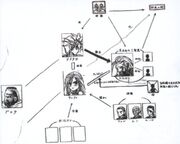
Early character relationships chart.
Tetsuya Nomura was chosen to draw the character designs by Hironobu Sakaguchi. The company used a system where everyone would put out plans regardless of their section, and while everyone handed in text documents they had made on a PC, Nomura's were hand-written and illustrated. Sakaguchi thought the illustrated proposals were amusing and chose Nomura to draw the characters.[12] The first characters Tetsuya Nomura created for Final Fantasy VII were Cloud and Aeris, followed by Barret.
At the very start of development the scenario wasn't complete yet, but I went along like, 'I guess first off you need a hero and a heroine', and from there drew the designs while thinking up details about the characters. After I'd done the hero and heroine, I carried on drawing by thinking what kind of characters would be interesting to have. When I handed over the designs I'd tell people the character details I'd thought up, or write them down on a separate sheet of paper.
Tetsuya Nomura
Unlike with Final Fantasy VI that had an ensemble cast, Cloud was planned as the main character since the beginning.[9] Nomura helped create the basic story, and the team came up with the characters during that time. He cites Barret and Cait Sith as two characters he had wanted to create for a long time, but everyone else was created during the writing of the story.[9]
Zack did not exist until late and was the last character Tetsuya Nomura drew for the game; it was thought Cloud would remind Aeris of her first love, but who this person would be wasn't decided on before Zack was made, and it was decided Cloud's self-made persona would be based on Zack's.[13] Nomura wanted a four-legged character in the game and thus Red XIII was born. Nomura was the one to come up with the name; he wanted it to be "interesting" and combined a number with a color.[13] Yuffie and Vincent were almost cut from the game due to lack of time, and they became optional characters.[13]
In early 1996, when Final Fantasy VII was around 15% complete, Square unveiled screenshots showing the characters Cloud, Barrett, Aerith and Red XIII.[10]
Visuals and Art Direction
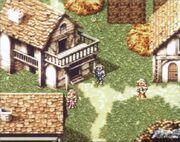
Concept image early in the development featuring an isometric view and Final Fantasy VI character designs, including Locke.
The game follows in the footsteps of Final Fantasy VI in presenting a world with more advanced technology than previous installments. The gamut of the game's technology covers space flight, robotics, advanced genetic engineering, automatic firearms, directed energy weapons, automobiles, helicopters, limited anti-gravity technology, and major global corporations; the level of technology in the world of Final Fantasy VII could be said to approximate that of near-future science fiction.
Visually, the goal was to make Final Fantasy VII a completely unified work with a single style running from beginning to end, including the cutscene movies, overworld map, and battle scenes. The aim was for all the compositions and shots to be suffused with meaning and show the intent of the creators. For all previous games during brainstorming phases there had always been the knowledge of the hardware memory limitations, but with Final Fantasy VII there were no restraints. That difference in available memory had a big influence on the development with the painterly visuals, and a better sense of space and composition.[9]
Without changing the basic gameplay the visuals and sound effects have been significantly enhanced, further drawing the player's emotions into the game. One way RPGs force too many images and too much sound onto the players robbing them of the feel of control. In order to avoid those responses we did extensive research during Final Fantasy V and VI in how to make players feel interactively involved in the game while upgrading the visual and sound effects. The results of this research are reflected in Final Fantasy VII.
Hironobu Sakaguchi on Squaresoft Collector's Video from 1997[14]
Kitase has described the process of making the in-game environments as detailed as possible to be "a daunting task." The series' long-time character designer, Yoshitaka Amano, was busy opening art workshops and exhibitions in France and New York, which limited his involvement. This was addressed by bringing Nomura on board as the project's main artist, while Amano aided in the design of the game's world map. Yoshitaka Amano did do some illustrations for the world of Final Fantasy VII, with some of his work appearing as a fresco on a wall in the game.[9]
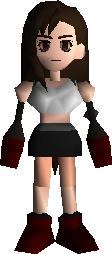
Tifa's character model.
There were two directions the development of Final Fantasy VII could have taken; either use pixel characters on 3D maps (like Xenogears) or render the characters using polygons. Upon release, Final Fantasy VI was met with widespread critical acclaim, but wasn't a huge commercial success in North America. Hironobu Sakaguchi has later lamented that in terms of the pixel art and the character size, the game "didn't jive" and that's why Final Fantasy VII got bigger with 3D models and CGI graphics.[15] At first the development team were considering pixel art for Final Fantasy VII, but decided it wouldn't be possible to make a realistic drama that way, whereas with polygon characters the movement of their entire bodies could be used for expression. Kitase has mentioned the game Alone in the Dark as inspiration for this style.[16]
Since the characters were going to be rendered in real-time, the chibi-style design used in previous games wasn't going to work, but not using the super-deformed style meant there were no limits on how to animate the characters. In the previous games it would have looked silly to have them ride a motorcycle, but by changing the characters' dimensions, the team was able to have the characters ride different vehicles.[9]
Sakaguchi wanted to follow the tradition of the pixel graphics, and to show the characters' expressions on the field screens, so attention was paid to the size of the characters' heads. In battles it is possible to zoom in, but since the field screens are a single background image, it is not possible to do that there. As a result, the characters' proportions are different in battle and on the field. Afterward the team thought players will feel something is off with the discrepancy, and so in Final Fantasy VIII the character proportions on the field and battle were kept the same.[16]
Character movement during in-game events was done by the character designers in the planning group. Normally, those designers convey what they want to a motion specialist, who then animates them, but with Final Fantasy VII the character designers learned how to do the motion work. That's why each character's movements differ depending on who created them, as some designers liked exaggerated movements, while others preferred more subtlety. For the character battle animations, however, the team had motion specialists for each character. Most time was spent on the typical, everyday motions to depict the characters' personalities.[9]
In Square's previous games most of the field graphics were done with a fixed top-down perspective. For example, a town map would be composed of various sprites: houses, streets, foliage, fences. With Final Fantasy VII maps could be presented as one seamless image, allowing for complex environments to be created. The goal was to provide a "lived-in feel" by for example furnishing houses with beds and individual toilets.[9]
The transition from 2D computer graphics to 3D environments overlaid on pre-rendered backgrounds was accompanied by a focus on a more realistic presentation. While the extra storage capacity and computer graphics gave the team the means to implement more than 40 minutes of full motion video, this innovation brought the added difficulty of ensuring the inferiority of the in-game graphics in comparison to the full motion video sequences would not be too obvious. The aim was to seamlessly join the movies and the game parts, and this approach is seen in the game's opening where the camera zooms in from a shot of the entire Midgar to Cloud jumping off the train. This was Square's first time implementing FMV movies to a game and they used an outside CG company for making the scenes. When the trial version was completed, Square would want to change some of the movie scenes to match the changes made to the story, without knowing big changes are unusual and costly, as it is not possible to get retakes as easily as one can do with games. In the end the team made do with a few revisions.[16]
The green and blue of the game's logo set the theme for the color tone for the rest of the game as well, reflected in the Mako energy and Lifestream that play crucial roles.[17]
Story

Early concept art of Midgar.
The original script of Final Fantasy VII, written by Sakaguchi, was rather different from the finished product. Tetsuya Nomura has recalled how Sakaguchi "wanted to do something like a detective story." The first part of the story involved a "hot blooded" character named "Detective Joe" in pursuit of the main characters who blew up the city of Midgar, which had already been developed for the story.[18] Despite having written the original plot, Sakaguchi focused with developing the battle system rather than the final version of the story.
Yoshinori Kitase and Kazushige Nojima came up with the sections on AVALANCHE and Shinra, Cloud's backstory, and the relationship between Cloud and Sephiroth. Sakaguchi came up with the specifics on the Lifestream in his original plot, but this saw some work by Kitase and crew before being placed in the game.[18]
Sakaguchi wanted to craft a story that told of how someone having passed away does not mean they are gone, and to show a realistic death rather than a "Hollywood" sacrificial death that previous games in the series had done. These desires developed into the Lifestream, and Aeris's iconic death scene and subsequent continuing role in the lives of the cast.[19]
It was Tetsuya Nomura's idea to have a story where the player would chase Sephiroth. Following a moving enemy hadn't been done before in the Final Fantasy series, and Nomura thought chasing something would help pull the story along.[12]
Translation
Ted Woolsey, who had done the translation of Final Fantasy VI, was invited to do Final Fantasy VII and he traveled to LA where Square had invited him to the new headquarters, but ultimately Woolsey turned down the opportunity due to personal reasons.[20]
Sakaguchi insisted the game's English translation be conducted in-house by the original Japanese development team, as had been done with Final Fantasy and Final Fantasy IV.
Although the resulting translation was perhaps more true to the Japanese version than the previous game had been, it was criticized by some as awkward and containing numerous grammatical errors. The Windows port is based on the same localization script, but many lines were rewritten and many of the grammatical errors were corrected. In future games, Square would hire American translators to collaborate with the Japanese development team, instead of having the translation done entirely by one or the other.
The English localization was handled by a team consisting of approximately 50 staff members, led by Seth Luisi. He said the most difficult thing about the translation was making "the direct Japanese-to-English text translation read correctly in English" because the "sentence structure and grammar rules for the Japanese language is very different from English", making it difficult to make it seem "as though it was originally written in English."[21]
PC version development
Final Fantasy VII was the first Final Fantasy title to be ported to a Windows system. Shareholders felt Square was limiting their market by not delivering games for multiple platforms; the company thus started to update the old games to modern programming languages and platforms, and to port Final Fantasy VII to the PC. Eidos was chosen as the publisher, as at the time Eidos successfully converted and released Core's Tomb Raider from PlayStation to PC, and thus seemed like a company experienced in marketing and distributing PlayStation to PC conversions. Eidos bought the rights to publish Final Fantasy VII for the PC for a million dollars, and Square contracted out the port team in Honolulu.[22]
The PC port of Final Fantasy VII suffers from many problems. After the PlayStation version was finalized, Square shut down the Final Fantasy VII project and broke apart its development team; the coders, artists, managers, and equipment were either transferred to the Final Fantasy IX project, moved to other parts of the company, released from their contract, or simply deprecated. What is more, the programmers working on the port had never made a PC game before, and so it is ridden with architectural mistakes.
The only thing the port team could work with was the pre-compiled PlayStation data on backgrounds and FMV movies, because the computers used to render the originals were gone and the 3D models for the cinematics were no longer available. Many of the original artists and animators were contract workers and no longer with Square, so they couldn't help with the port. The original MIDI music was tweaked by audio engineers after being compiled into the PSX SEQ format; the original MIDIs the PC received were not even the final versions.[22] Square refused to have anything changed for the port, apart from the text input, because the game's original director was not part of the project and could not be consulted.
The PC version was released June of 1998, but it was buggy and initially incompatible with Cyrix and AMD CPUs. The PC version was ridden with problems from movies playing upside down or crashing the system, users' sound cards not being designed for MIDI playback, and the initial keyboard configuration using only the numeric keypad, meaning the game could not be played on many laptops. One of the most notorious flaws was a glitch that crashed the game during the Chocobo racing sequences; like most issues of the PC version, it was addressed with a fan-made patch.[1]
The game featured separate General MIDI and Yamaha XG MIDI files; a Yamaha S-YXG70 software synthesizer was provided on the install disc, which was, according to the readme, specially made for the game by Yamaha to make the XG MIDI files playable on computers without appropriate hardware. Additionally, the game is one of the very few Windows titles with support for Creative Labs' Sound Blaster AWE32/AWE64 ISA sound cards, as it provides a custom soundfont for their EMU8000 synthesizer.
Having learned from the Final Fantasy VII PC version mistakes, Square started a long-term project to "up-port" their core games and standardize all data, so the faults made with the Final Fantasy VII PC port would not happen again.[22] The later re-releases of old Final Fantasy games use a new 2D engine.[22]
PC version re-release
Rumors of Square re-releasing Final Fantasy VII for PC surfaced in 2012 when Square Enix purchased the domain for finalfantasyviipc.com. Product description for the new release was posted on the page, but was quickly removed; however, a number of news sites had got whiff of the scoop and the product description remained in Google cache.
On the July 4, 2012, the site was officially opened with information about the release, albeit without a release date. Later, the version was released on Steam. The re-released PC version includes new online features, such as cloud saving, achievements and the player can to boost characters' stats and gain more gil via a system known as "Character Booster."
iOS
At E3 2015 Square Enix announced that the PC re-released version of the game will be available on iOS in summer 2015.[23]
Remake
On June 15, 2015, the video game website Siliconera reported Final Fantasy VII is getting a remake and would be coming first to PlayStation 4, with other platforms to be announced at a later date. Later that day, during Sony's E3 conference, the announcement trailer for the remake showed scenes from Midgar, its slums and glimpses of Cloud and Barret. Yoshinori Kitase was announced as producer, Tetsuya Nomura as director and Kazushige Nojima as scenario writer. The remake announcement was met with wild enthusiasm and sent Square Enix's stock surging to its highest since November 2008, at the close in Tokyo trading.[24] The announcement trailer became the most-watched E3 2015 video game trailer.[25]
The project had been in development for some time before it was announced at E3. The announcement decision was done to boost PlayStation 4 sales in Japan, in the hopes of widening the install base by reassuring the platform will have games to look forward to.[26]
The team had plans for a remake on several occasions, but finally decided to do it. One of the main reasons was the timing for the staff members developing the game being suitable, and "hitting that age". Of the staff that worked on the original Final Fantasy VII, and those who are working on the remake, Tetsuya Nomura is the youngest at 45 years old. With the timing and opportunity in mind, the trio of Kitase, Nojima and Nomura decided to go for it.[27] Shinji Hashimoto, a Square Enix executive and Final Fantasy brand manager, came to Kitase and Nomura with the topic of the remake, as he had been involved with marketing and sales with the original version, and the game has a special place in his heart. Tetsuya Nomura assumed Kitase was to direct the remake, and was surprised when he realized he had been given the role.[28]
The remake will be different from the original game. Nomura has said that simply overhauling the graphics would not surpass the original version. He described the remake as "vastly evolved" to the story as "there will be more work added to it".[29] Parts of the announcement video will be used in the game.[30] The team will be looking to the movie Final Fantasy VII: Advent Children, which Nomura also directed, for visual references and inspiration.[31] It is unknown what engine the game will use, but it won't be Square's own Luminous Engine.[32]
My goal with the remake is to make it apply to the current era, the current generation of players that are going to be coming into contact with or playing FFVII for the first time through this remake. I want to make it so it's relevant to the modern era, as well as having an element of surprise. It has to be something that riles up this sense of wonder and amazement. I don't want to change it so much that it's unrecognisable, but make sure that it's something fresh and new [yet still] recognisable as FFVII. That's what I'll be keeping in mind as I work on this.
Tetsuya Nomura[33]
Nomura has said there are people even within Square Enix who put "too much of a focus on the 'VII-ness' and are resistant to changing it." He has said that the "FFVII-ness" isn't easily defined as it means different things for different people. Nomura wants to separate the feelings of nostalgia and being "trapped" by the series of the past, as in his opinion declaring "FF is like this" makes one unable to create a Final Fantasy game.[28]
Themes
The game incorporates allusions to a variety of religious and philosophical systems, reflected in character names like Sephiroth (drawn from the Kabbalah) and Heidegger (likely a reference to German philosopher Martin Heidegger), and place names such as Midgar and Nibelheim (both from Norse mythology), as well as numerous references in monster names, such as the Midgar Zolom, a reference to the Midgardsorm (also from Norse mythology). Additionally, several references are made to previous Final Fantasy titles, including several character names such as Cid and Biggs and Wedge, and the repetition of soundtrack motifs, such as the "Chocobo Theme."
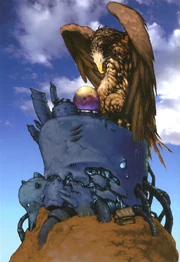
Juxtaposition of nature vs. technology portrayed at Fort Condor where a condor has made the Mako Reactor its nest.
Environmentalism and crony capitalism are major themes in Final Fantasy VII, with Shinra Electric Power Company having taken over the world after discovering Mako energy and becoming the world's only major electricity provider. Whether humanity is truly an important part of the ecosystem is contemplated when Bugenhagen reveals to the party the Planet's Ultimate White Magic spell can wipe out anything the Planet deems a danger, putting mankind's future in peril seeing as they have been exploiting the world's nature reserves wantonly.
The party decides to fight for the Planet regardless, and in the end humanity's true fate was left ambiguous, with only the non-human member of the party, Red XIII, appearing in the epilogue, although future installments to the Compilation have revealed mankind did survive. The interconnectedness of all life is part of the Lifestream study explored in Cosmo Canyon, and the party realizes this when they gaze down on the Planet from space, cognizant for the first time how small their world is in the vastness of the universe, reaffirming their conviction to protect it. The Planet itself gains anthropomorphic properties with the Cetra being able to enter in communion with it in a ritual known as "talking to the Planet," and in Cosmo Canyon the party can listen to the "cry of the Planet" in suffering under exploitation from Mako harvest.
In the end the forces of nature prove greater, as despite all their power Shinra crumbles when faced with the Planet's true might when the Meteor is summoned and the Weapons awaken. The collective power of all life is required to save the Planet from Meteor, when Aeris, perhaps representing humanity itself, summons the Lifestream to push back the Meteor allowing Holy to destroy it.
Release
Template:See Also
Japanese Release
Overseas Release
The North American and PAL versions of Final Fantasy VII made substantial changes to the original Japanese version. Several areas of gameplay have been made more difficult by adding in new bosses. Random battle rates were cut down, and Materia swapping between characters was made easier. New flashbacks of Tifa meeting the semi-conscious Cloud on a train station, and a flashback of Cloud and Zack escaping Nibelheim, were also added in.
The game's United States marketing budget amounted to $100 million,[34] equivalent to $149 million in 2015.[8] Combined with the development budget of $45 million,[7] this brings the game's total budget up to $145 million, equivalent to $215 million in 2015.[8]
Final Fantasy VII International
The North American version of Final Fantasy VII was re-released in Japan, called "Final Fantasy VII International", the very first International Version, a semi-recurring feature of the series. It includes Final Fantasy VII: Perfect Guide, a special fourth disc with maps, character information, design sketches, and other trivia. A later limited version, Final Fantasy VII International Advent Pieces: Limited was released in a collectible metal case that could be assembled into a display stand.
PC version
PC version re-release
The game was released on PC to both Europe and North America on August 14th, 2012. The game is available on the Square Enix website. The re-release version of Final Fantasy VII showed up for sale on the website on the night of 5th of August 2012, but was quickly pulled by Square. Those who were fast enough to download the game found their copies not working, as the automatic license activation (through the SecuROM DRM) and manual serial number entry failed. The price attached to these early sales was $12.70.[35] It later turned out the early release was related to testing the product website for the upcoming relaunch, and while the website was being tested a small number of people were able to purchase a pre-release build of the game. For those customers, Square Enix offered a refund and a free version of Final Fantasy VII on PC upon its launch.[36]
A PC version of Final Fantasy VII International was released in Japan May 16th, 2013, made available on the Japanese Square website.
The game was released on Steam on July 4, 2013. This version is the same as the 2012 release, and any achievements earned in the other version carry over to the Steam version as soon as the game is started.
On 27th September 2013 Square Enix announced to have upgraded the audio in the game, due to various player complaints on the background music quality.[37]
System Requirements
| Minimum | |
|---|---|
| OS | Microsoft Windows XP/Vista/7 (32/64bits) |
| Processor | 2GHz |
| Memory | 1 GB RAM |
| Graphics | DirectX 9.0c-compatible graphic card |
| Hard Drive | 3 GB available space |
| Others | DirectX 9.0c Square Enix account |
PlayStation 4
Port of 2012 PC Re-release
On December 6, 2014, at PlayStation Experience event in Las Vegas, Shinji Hashimoto announced that Final Fantasy VII will be re-released on PlayStation 4. This version will be based on the 2012 PC re-release version.[38] It was originally slated for a spring 2015 release, but in E3 2015 Square Enix conference it was announced its release had been delayed to winter 2015.[39]
Remake
A full remake was announced during E3 2015. Tetsuya Nomura, the director of this remake stated that it will not be the exact same as the original and the official title of this version will be announced later.
Reception
Final Fantasy VII was a critical and commercial success. It received glowing reviews from most video game magazines and by 1999 the game had sold more than eight million copies worldwide, with about three million in the first 48 hours of its release. It was one of the first console role-playing games to achieve widespread popularity outside of Asia, and the ongoing popularity of the title led Square Enix to produce a series of sequels and prequels under the collective title Compilation of Final Fantasy VII in the mid-2000s.
Not counting spin-off or related titles (such as Final Fantasy Mystic Quest), Final Fantasy VII was the first Final Fantasy title to be released in Europe and Australia, and it was the first Final Fantasy game to be released under the same name in both Japan and North America since the original NES Final Fantasy. This fact caused some initial confusion among North American consumers.
Japan's Final Fantasy II, Final Fantasy III, and Final Fantasy V were not released in North America; instead, Final Fantasy IV and Final Fantasy VI were released as America's Final Fantasy II and Final Fantasy III respectively. The American series thus effectively jumped from III to VII when Final Fantasy VII was released although the game was the next sequential release. It caused even more confusion among European consumers with misled thoughts of there being six other games dealing with Cloud and his friends' adventures.
Commercial Reception
The game's demand in Japan reportedly exceeded that of the PlayStation's Japanese user base at the time.[6] In the game's debut weekend in North America, it sold 330,000 copies and grossed $16.5 million (equivalent to $24.34 million in 2014[8]), setting an industry record and earning more than the top-grossing film G.I. Jane during Labor Day weekend;[40] its success made it a killer app for the PlayStation.[41]
The PlayStation Network release of the game was downloaded 100,000 times during its first two weeks of release, making it the fastest-selling PlayStation game on the PlayStation Network.
| Platform | Sales | Revenue (no inflation) |
Revenue (2015 inflation) |
|---|---|---|---|
| PlayStation | 10,000,000[42] | $781 million[43] | |
| PSN | 100,000[44] | $1.5 million[45] | |
| Steam | 953,310[46] | $11.4 million[47] | |
| Overall | 11,053,310 | $794 million | $1.18 billion[8] |
Critical reception
Upon release, the game received widespread critical acclaim.
In Japan, Famitsu's panel of four reviewers gave it scores of 9, 10, 9 and 10 out of 10, adding up to 38 out of 40 overall, making it their highest-rated game of the year, their highest-rated Final Fantasy game at the time, and one of their eleven highest-rated games up until 1997.[103]
In North America, GameFan called it "quite possibly the greatest game ever made," a quote which featured prominently on the back cover of the game's jewel case.[104]
In the United States, Electronic Gaming Monthly's panel of four reviewers gave the game scores of 9.5 out of 10 each, adding up to 38 out of 40 overall.[59]</ref>[105] GamePro praised the "massive world," experimentation "with spells and weapons, encounters with weird creatures," and "soap opera-ish story line", concluding it has "classic" written "all over it."[67] Game Informer called it "the most amazing RPG we've ever seen"[106][107] and "the best RPG ever made."[64] Just Adventure called it "the greatest game ever created" and "a work of art" and "masterpiece that goes beyond video games." They praised the "very dark and emotional story" as "beautifully conceived" and called it "a very inspirational and powerful video game."[80]
In the United Kingdom, Edge noted, "The 'interactive movie' has long been a dirty term to anyone who values a playable videogame, but FFVII succeeds in coming closer than any title yet," with the "highly complex, melodramatic story and excellently orchestrated chip music" combining "to make players feel real empathy with the characters," a "task usually shied away from by the action/comedy-orientated western graphic adventures."[108] Paul Davies of Computer and Video Games described it as "truly unique" and "an incredible new era of interactive entertainment" that could "revolutionize" belief of "what a video game can achieve", with arguably "some of the best moments in entertainment history", including "excitement" and "heart-rendering" emotional scenes, concluding that, with a "thrilling" storyline "brought to life with ingenious" gameplay, the "future of PlayStation is assured by this key to the future of games."[53] Alex C of Computer and Video Games stated that the characters "are well developed," comparing their "ups and downs" to a film, and that the "structure of the story is such that, just when you think you've seen it all, something even more awesome comes along to totally knock your socks off."[54]
PC Zone credited Final Fantasy VII for achieving "the formidable task of making role-playing cool", noting its mainstream coverage in "style press" magazines such as The Face.[86]
Awards
Final Fantasy VII won many Game of the Year awards for 1997. It won an Origins Award in the "Best Roleplaying Computer Game of 1997" category.[109] At the second CESA Awards (now Japan Game Awards), it won the "Grand Prize" and the "Best Scenario" and "Best Sound" awards.[110] At the first Japan Media Arts Festival, it won an "Excellence Prize" in the "Digital Art (Interactive Art)" division.[111]
It was also awarded the Readers' Choice awards for "All Systems Game of the Year", "PlayStation Game of the Year", "Role-Playing Game of the Year", "Best Graphics of the Year" and "Best Music of the Year" by Electronic Gaming Monthly,[112] as well as their Editors' Choice awards for "Role-Playing Game of the Year", "Best Graphics",[113] "Hottest Video Game Babe" (for Tifa Lockheart), "Most Hype for a Game", "Best Ending", and "Best Print Ad",[114] in addition to Readers' Choice nominations for "Most Original Game of the Year" and "Best Sound of the Year",[112] and Editors' Choice nominations for "All Systems Game of the Year" and "PlayStation Game of the Year".[113]
| Publications | Awards |
|---|---|
| GameFan,[63] Fun Generation[61] | Game of the Month |
| Electronic Gaming Monthly[59] | Game of the Month, Editors' Choice Gold Award |
| Academy of Interactive Entertainment, Game Informer, Japan Game Awards, Japan Media Arts Festival |
Game of the Year |
| Electronic Gaming Monthly (Readers' Choice)[112] |
All Systems Game of the Year, PlayStation Game of the Year, Role-Playing Game of the Year, Best Graphics of the Year, Best Music of the Year, Most Original Game of the Year (Write-In), Best Sound of the Year (Write-In) |
| Electronic Gaming Monthly (Editors' Choice)[113] |
Role-Playing Game of the Year, Best Graphics |
| Electronic Gaming Monthly (1998 Video Game Buyer's Guide)[114] |
Hottest Video Game Babe (Tifa Lockheart), Most Hype for a Game, Best Ending, Best Print Ad |
| GamePro[115] | Best Console Game of 1997, Best Role-Playing Game |
| Gamezilla[116] | Best Role-Playing Game |
| Interactive Achievement Awards[117] | Console Adventure Game of the Year, Console Role Playing Game of the Year |
| Origins Award[109] | Best Roleplaying Computer Game of 1997 |
| RPGFan[118] | Overall Best RPG, Best PSX RPG, Quest Length, Best Graphics, Coolest Faction (The Turks) |
| Dengeki,[119][120] GameFAQs,[121][122] GameSpot,[123][124] IGN[125][126] |
Best Game of All Time |
| Famitsu (2000)[127] | Top PlayStation Game of All Time |
| IGN (2000)[128] | PlayStation Game of the Century, PlayStation RPG of the Century |
| Dengeki (2007)[119] | Best Story of All Time |
| Dengeki (2007),[119] GamePro (2008)[129] | Best RPG of All Time |
| Sony Computer Entertainment (2014)[130] | Most Wanted Remake or Sequel |
Polls
In a Famitsu character popularity poll, Final Fantasy VII had six characters (Cloud, Tifa, Sephiroth, Aerith, Zack, and Yuffie) place. This is the most amount of characters from any one game listed. Final Fantasy VII was the winner of the 2004 GameFAQs user poll contest "Best. Game. Ever.", beating the fellow Square RPG, Chrono Trigger. However, in GameFAQs second "Best. Game. Ever." poll, the game finished runner-up to The Legend of Zelda: Ocarina of Time. It came 2nd in Empire magazine's 2010 feature "100 Greatest Videogames Ever", beaten only by Super Mario World.[173] In 2012, Final Fantasy VII got #33 in G4's "Top 100 Games of All Time" beating Gears of War 3, Fallout 3 and Halo: Combat Evolved.
On December 3, 2014 Final Fantasy VII was voted by the Japanese fans as one of the best five PlayStation games of the brand's 20 years lifespan, along with Final Fantasy X, Grand Theft Auto V, Metal Gear Solid 3: Snake Eater, and Monster Hunter Freedom Unite.[174]
Legacy
Since 1997, Final Fantasy VII has been chosen by many game magazines and other publications as one of the best video games ever made. Most recently, in 2012, Time named it one of the "All-TIME 100 Video Games".[175] Historically, Final Fantasy VII became an influential watershed of the 3D generation of consoles and games that would use the format in the 1990s, and helped establish the format's succession as the new technological frontier and standard for the mainstream industry.
In 2013, GamePro included Final Fantasy VII in its "20 most innovative games ever made" list. They stated described it as "a classic that touched an entire genre of gaming" and "an entire generation of gamers." They also stated that its "status as an early PlayStation One exclusive gave Sony the edge it needed to compete in and eventually dominate the video game industry."[176] In 2008, game designer Peter Molyneux stated that Final Fantasy VII was the game that defined the RPG genre.[177]
Final Fantasy VII has also often placed at or near the top of many reader polls of all-time best games. Most recently, in 2014, Sony Computer Entertainment conducted a poll with over 10,000 Japanese fans, where Final Fantasy VII was voted the second favorite PlayStation game of all time (behind Dragon Quest V: Hand of the Heavenly Bride), the second best game that impressed "more than a movie or a novel" (behind Final Fantasy X), and the most wanted remake.[178]
Compilation of Final Fantasy VII
After the new millennium Yoshinori Kitase and Tetsuya Nomura were approached and asked for a game that could be expanded across multiple platforms and mediums. Final Fantasy VII was chosen, which led to the creation of the Compilation of Final Fantasy VII. To date, the compilation includes two mobile phone games, one sequel game, one prequel game, one full-length CGI film, an OVA, and several short novellas.
The games within the collection have expanded on the story of Final Fantasy VII both before and after the original game, but have been met with mixed reactions for a number of reasons, including various retcons and liberties taken with the original storyline and characters.
Rumored Remake
In 2005 at the Sony E3 annual press conference, Square Enix showed a technical demo for the PlayStation 3 depicting the opening sequence to the original Final Fantasy VII remade with the PlayStation 3's enhanced graphics. Square Enix later made an official statement of there being no plans of a remake of Final Fantasy VII for the PlayStation 3.
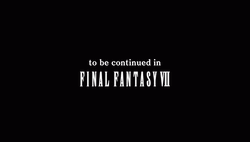
"To Be Continued".
The rumors were sparked a second time with Square Enix's exhibition of new FMV artworks during the Final Fantasy VII 10th Anniversary event in Japan. The artworks[179] depicted the characters in their Final Fantasy VII costumes, reigniting rumors a remake of the game may be in development. These CG artworks were printed on the new canned Potion beverages. Kazuo Hirai, the president of Sony Computer Entertainment Japan, also fueled the rumors by sticking a small note in the exhibition saying "Congratulations for the ten fantastic years! The best is yet to come".
The release of Crisis Core -Final Fantasy VII- brought new speculation to the possibility of a remake; the ending shows the beginning of Final Fantasy VII in a modern CG style, followed by a title card reading "to be continued in FINAL FANTASY VII", in reference to the original game.
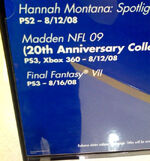
False Final Fantasy VII (PS3) remake advertisement.
Rumors surfaced again due to photos of a Best Buy ad stating the game was to be released on August 16, 2008.
Despite excitement surrounding the chance of a remake, Square Enix has consistently denied any and all rumors on several occasions. With photos of an ad for CLOUD Vol.2 appearing on the Internet, the excitement rose yet again. The ad was revealed to be for a book.
Final Fantasy VII was released on the PlayStation network for PlayStation 3 and PlayStation Portable in 2009 with Japan's release in April and the US and Europe following in June. It costs $9.99 in the US and £7.99 in the UK and has remained rated T for Teen by the ESRB.
In December of 2009, Tetsuya Nomura hinted an announcement is to come sometime in 2010 promising a game highly requested by fans—some of which have personally requested it from him, and the reaction he expects from the announcement is downright huge. Again this led to immense speculation of a Final Fantasy VII remake.
In January of 2010, Tetsuya Nomura followed up on his previous statement stating "Fans are looking forward to an often rumored remake of Final Fantasy VII, but I don't believe this will happen for the time being". For some this seemed like the end, but others argue that "for the time being" means a remake could surface in the future.
In February 2010, Yoshinori Kitase stated he would like to take part in a remake of Final Fantasy VII in the future, but it was not in his immediate plan.
At the beginning of March 2010, Square Enix asked the public, on its official Twitter blog, what they would think of a remake.
On March 22, 2010, Square Enix CEO Yoichi Wada stated the company would "explore the possibility—whether or not we're going to do it, if we're going to do it, and the platform".[180]
On May 31, 2010, Square Enix's CEO Yoichi Wada stated it would take longer than he is prepared to invest in a single project to be able to remake Final Fantasy VII. Since Square Enix receives so many requests for a remake, the prospect for a remake has not been completely ruled out.[181]
In May 2012, Tetsuya Nomura addressed the fans' demand for a Final Fantasy VII remake in a Famitsu interview by saying that newer games (such as Final Fantasy XV) take precedent over such projects, because the developers want to create new Final Fantasy games that can surpass peoples' expectations instead of remaking classics.[182]
In February 2014, Yoshinori Kitase stated in an interview with Eurogamer[183] that he would love to do an HD remake of Final Fantasy VII, but that it would take a lot to make such a project a reality. Kitase mentioned staff availability and budget as two major barriers to the project being greenlit, as well as his personal motivation to create it, as he admits that though he casually says he would like to do a remake, it would be a huge project.
A Final Fantasy VII PC modding community have spent the best part of about 10 years working on a number of different mods, predominantly for the PC version of Final Fantasy VII, but some of the modding community have been working on PS versions. The patches have been known to improve both the Audio/Visual experience as well as the gameplay.
Gametrailers.com listed Final Fantasy VII on their "Top 10 Necessary Remakes" at #2.[2]
Despite many doubts and after years of rumours, on June 15, 2015, the anticipated remake of Final Fantasy VII was announced at E3 2015.
Production credits
Original
| Producer | Hironobu Sakaguchi |
|---|---|
| Executive Producers | Tetsuo Mizuno, Tomoyuki Takechi |
| Director | Yoshinori Kitase |
| Music | Nobuo Uematsu |
| Main Programmer | Tatsuya Yoshinari |
| Image Illustrator | Yoshitaka Amano |
| Story | Yoshinori Kitase, Kazushige Nojima |
| Battle Programmers | Kazumasa Fuseya, Hiroshi Harata, Akihiro Yamaguchi |
| Character Designer | Tetsuya Nomura |
| Art Director | Yusuke Naora |
| 2D Animators | Kenichirou Okamoto, Hiroyuki Yotsuji |
| Chief CG Programmer | Masaharu Inoue |
| Movie Director | Motonori Sakakibara |
| Monster Designers | Shin Nagasawa, Tetsu Tsukamoto |
| Battle Programmers | Kazumasa Fuseya, Hiroshi Harata, Akihiro Yamaguchi |
| Field Programmer | Keizo Kokubo |
| World Map Programmer | Yasuo Kuwahara |
| Snowboard Programmer | Tadamichi Obinata |
| Condor War Programmer | Ryo Muto |
| Chocobo Race Programmer | Keitaro Adachi |
| Submarine Chase Programmer | Shin-ichi Tanaka |
| Highway and Roller Coaster Programmer | Tatsuya Yoshinari |
| Field CGI and Movie Designers | Yuko Akiyama, Kanako Aoki, Hiroyuki Honda, Ayako Kuroda, Yoshinori Moriizumi |
| Concept Art | Takayuki Odachi, Tetsuya Takahashi |
| Map Plan Director | Hidetoshi Kezuka |
| Battle Plan Designer | Matsumura Yasushi |
| Movie Programmer | Shun Moriya |
| Sound Programmer | Minoru Akao |
| Character Programmer | Hiroshi Kawai |
| CG Supervisor | Kazuyuki Hashimoto |
Remake
| Producer | Yoshinori Kitase |
|---|---|
| Director | Tetsuya Nomura |
| Scenario | Kazushige Nojima |
| Character Designers | Tetsuya Nomura, Roberto Ferrari |
Packaging Artwork
Final Fantasy VII was the first Final Fantasy game whose Japanese game cover was just the logo on white background, a tradition that has continued ever since. At first, Square were talking about removing the lettering of the logo and just having the image of Meteor Yoshitaka Amano had drawn, but it didn't materialize. The background was chosen to be white because Hironobu Sakaguchi said that the image of Final Fantasy was white.[184]
Template:Gallery
Gallery
Template:See Also Template:Gallery
Allusions
Final Fantasy VII makes references to the number 7, the rest of the Final Fantasy series, as well as mythology, folklore and religion, and popular culture, the Loveless' album by My Bloody Valentine as a known example, among others.
Trivia
- Square had considered a Final Fantasy VII remake for PlayStation 2 in early 2001. The project was either scrapped or never started development.
- Final Fantasy VII is the first Final Fantasy game to show blood in a scene.
- During the scene where the Sister Ray is about to fire at Diamond Weapon, a voice can be heard over an intercom.[185] (This is hardly audible due to the music that continues to play in the background. It can be heard while viewing the cutscene video clip that is on the PC version).
- There are four other examples of audible vocalization in the game: in the FMV sequence when Midgar's Sector 7 plate is collapsing onto the slum underneath, the slum's residents give a frightened scream. At the end of this sequence, President Shinra observes the chaos below from his top floor office in Shinra Tower listening to opera music. During the Safer Sephiroth battle "One-Winged Angel" includes vocalized lyrics. And lastly, children's laughter is heard as the epilogue sequence draws to a close. These make Final Fantasy VII the first game in the series with audible voice acting. The voice actors involved are unknown and not named in the credits.
- Kazushige Nojima, along with Yoshinori Kitase, has stated in the Final Fantasy X-2 Ultimania interview that Spira from Final Fantasy X is the 'ancestor' civilization which colonized the Planet of Final Fantasy VII. This is reinforced by Shinra's mention of potentially harnessing the Farplane as an energy source, which his descendants would go on to do with the Lifestream many centuries later, as the Shinra Electric Power Company.
- Final Fantasy VII appeared, along with Final Fantasy Tactics, in Smithsonian Art of Video Games exhibit held between March 18 and September 30 2012. The video games in the exhibition were decided by public vote.
- The original 1998 trailer of Final Fantasy VII features a piece of music called "Final Encounter" by Steve Baker that isn't featured in the game or soundtrack.[186]
- Xenogears started out as an early concept conceived by Tetsuya Takahashi and Kaori Tanaka for Square's Final Fantasy VII. The company deemed it "too dark and complicated for a fantasy", but Takahashi was allowed to develop it as a separate project.[187]
See Also
- Final Fantasy in Popular Culture
- Final Fantasy VII Demo
- Final Fantasy VII Technical Demo
- Final Fantasy VII Allusions
- Final Fantasy VII Artworks
- Final Fantasy VII Timeline
- Final Fantasy VII Wallpapers
- Final Fantasy VII Achievements
- Version Differences
References
- ↑ Final Fantasy VII Has Sold Over 11 Million Units Worldwide (Accessed: UnknownError: See this for how to archive.) at Siliconera
- ↑ Uematsu Confirms Zero Involvement With Final Fantasy VII Remake (Accessed: UnknownError: See this for how to archive.) at Final Fantasy Union
- ↑ "Yoshinori Kitase interview". Level (in Swedish) (Reset Media) (25). May 2008.
- ↑ Final Fantasy VII: An Interview With Squaresoft, Computer and Video Games, issue 191, October 1997, pages 53-9
- ↑ Andrew Vestal, The History of Final Fantasy, GameSpot, CBS Interactive
- ↑ 6.0 6.1 Final Fantasy VII, Computer and Video Games, issue 185, April 1997, pages 88-93
- ↑ 7.0 7.1 Essential 50: Final Fantasy VII, 1UP
- ↑ 8.0 8.1 8.2 8.3 8.4 CPI Inflation Calculator, Bureau of Labor Statistics
- ↑ 9.00 9.01 9.02 9.03 9.04 9.05 9.06 9.07 9.08 9.09 9.10 9.11 9.12 9.13 Final Fantasy VII – 1997 Developer Interviews
- ↑ 10.0 10.1 10.2 "Final Fantasy VII", Computer and Video Games, issue 174, May 1996, pages=106-11
- ↑ Kenny Sutherland, Elusions: Final Fantasy 64, Lost Levels
- ↑ 12.0 12.1 Weekly Famitsu Issue no. 1224: Tetsuya Nomura Interview translated by TheLifestream.net
- ↑ 13.0 13.1 13.2 13.3 FFVII 10th Anniversary Discussion: p. 8 to 13 of the FFVII 10th Anniversary Ultimania translated by TheLifestream.net
- ↑ Hironobu Sakaguchi / Final Fantasy VII - Squaresoft Collector's Video 1997
- ↑ Things Are Very Different For The Creator Of Final Fantasy — Kotaku.com
- ↑ 16.0 16.1 16.2 Weekly Famitsu Issue no. 1224 Yoshinori Kitase Interview translated by TheLifestream.net
- ↑ http://finalfantasynews.com/2015/02/27/yusuke-naoras-smu-lecture-recap-featuring-new-final-fantasy-xv-concept-art/
- ↑ 18.0 18.1 http://uk.ign.com/articles/2007/06/04/ffvii-not-being-remade-nomura
- ↑ EDGE magazine, May 2003
- ↑ Transcript of Ted Woolsey interview
- ↑ Electronic Gaming Monthly, issue 94, May 1997, pages 91 & 94
- ↑ 22.0 22.1 22.2 22.3 http://q-gears.sourceforge.net/index.phtml?content=4
- ↑ http://www.siliconera.com/2015/06/16/original-final-fantasy-vii-coming-to-ios-then-to-playstation-4/
- ↑ Square Enix Wins Cheers, Share Gain on Final Fantasy Trailer (Accessed: UnknownError: See this for how to archive.) at Bloomberg
- ↑ So people are really into this Final Fantasy VII remake (Accessed: UnknownError: See this for how to archive.) at Destructoid
- ↑ Final Fantasy 7 remake was underway before the PS4 PC port was announced (Accessed: UnknownError: See this for how to archive.) at Eurogamer
- ↑ Why Square Enix Decided To Finally Make The Final Fantasy VII Remake (Accessed: UnknownError: See this for how to archive.) at Siliconera
- ↑ 28.0 28.1 FFVII Remake: Nomura interview translation [Famitsu 25/06/15] (Accessed: UnknownError: See this for how to archive.) at Lifestream
- ↑ Final Fantasy VII Remake Will Have More Work Done To Its Story (Accessed: UnknownError: See this for how to archive.) at Siliconera
- ↑ Final Fantasy VII Remake won’t have new characters (Accessed: UnknownError: See this for how to archive.) at Gematsu
- ↑ 'Dramatic changes' and Advent Children will help shape the Final Fantasy 7 Remake (Accessed: UnknownError: See this for how to archive.) at Gamesradar
- ↑ Final Fantasy 7 remake won’t be built on Square’s Luminous engine (Accessed: UnknownError: See this for how to archive.) at VG247
- ↑ Final Fantasy VII director: remake won't be a direct upgrade (Accessed: UnknownError: See this for how to archive.) at Wired
- ↑ http://www.eurogamer.net/articles/2013-06-02-final-fantasy-7-retrospective
- ↑ http://www.joystiq.com/2012/08/05/final-fantasy-vii-pc-released-early-then-pulled/
- ↑ http://kotaku.com/5932509/square-enix-offering-free-copies-of-final-fantasy-vii-to-anyone-who-accidentally-bought-it-last-weekend
- ↑ http://eu.square-enix.com/en/blog/final-fantasy-vii-music-%E2%80%93-now-updated
- ↑ http://www.siliconera.com/2014/12/06/final-fantasy-vii-is-coming-to-playstation-4-but-this-is-not-a-remake/
- ↑ http://www.siliconera.com/2015/06/16/original-final-fantasy-vii-coming-to-ios-then-to-playstation-4/
- ↑ PlayStation's "Final Fantasy VII" Breaks Industry Records in Debut Weekend, Business Wire, September 1997
- ↑ Justin Olivetti, The Game Archaeologist and the What Ifs: True Fantasy Live Online, Joystiq, June 14, 2011
- ↑ http://arstechnica.com/gaming/news/2010/05/masterpiece-final-fantasy-vii.ars
- ↑ 10 million units sold = $781 million
- ↑ http://web.archive.org/web/20090628114657/www.gamepro.com/article/news/210963/final-fantasy-vii-downloaded-100-000-times-in-two-weeks/
- ↑ 100,000 PSN units at $14.99 each = $1.5 million
- ↑ http://steamspy.com/app/39140
- ↑ 949,972 units at $11.99 each = $11.4 million
- ↑ http://www.1up.com/reviews/final-fantasy-vii_2
- ↑ http://www.absolute-playstation.com/api_review/rffv7.htm
- ↑ http://web.archive.org/web/20100102143231/allgame.com/game.php?id=43810
- ↑ http://web.archive.org/web/20141114121120/www.allgame.com/game.php?id=9411
- ↑ http://www.brashgames.co.uk/2014/12/20/final-fantasy-vii-review/
- ↑ 53.0 53.1 Final Fantasy VII, Computer and Video Games, issue 192, November 1997, pages 52-5, EMAP
- ↑ 54.0 54.1 Alex C, Final Fantasy VII: The game that made RPGs cool, Computer and Video Games, August 14, 2001
- ↑ http://web.archive.org/web/20020225155058/www.cdmag.com/Home/home.html?article=/articles/013/106/ff7_review.html
- ↑ http://web.archive.org/web/20001001155220/www.gamespot.com/rpg/finalf7/review_cgw.html
- ↑ http://web.archive.org/web/20110713234646/www.lowbrowculture.com/edge/?querytype=publisher&query=Squaresoft
- ↑ 58.0 58.1 58.2 58.3 58.4 58.5 58.6 58.7 58.8 http://www.gamerankings.com/ps/197341-final-fantasy-vii/articles.html
- ↑ 59.0 59.1 59.2 Electronic Gaming Monthly, issue 99 (October 1997), page 50
- ↑ http://web.archive.org/web/20080714074152/fs.finalfantasytr.com/search.asp?query=final+fantasy
- ↑ 61.0 61.1 Fun Generation, 11/97
- ↑ https://web.archive.org/web/20051102201923/www.gamesarefun.com/gamesdb/review.php?reviewid=483
- ↑ 63.0 63.1 GameFan, volume 5, issue 9, September 1997, pages 26 & 67-70
- ↑ 64.0 64.1 Game Informer, issue 53, September 1997, pages 10-11
- ↑ http://www.gamekult.com/jeux/test-final-fantasy-vii-SU3010000121t.html#ps
- ↑ GamePro, issue 104 (May 1997), pages 32-33
- ↑ 67.0 67.1 GamePro, issue 109 (October 1997), p.46-47 (Link)
- ↑ http://web.archive.org/web/20100222062048/www.gamepro.com/article/reviews/824/final-fantasy-vii/
- ↑ http://www.gamerevolution.com/review/final-fantasy-vii
- ↑ https://web.archive.org/web/20011029225215/www.gameshark.com/psx/articles/303884p1.html
- ↑ https://web.archive.org/web/20030415172507/www.gamespot.com/ps/rpg/finalfantasy7/review.html
- ↑ https://web.archive.org/web/20071023093150/www.gamespot.com/pc/rpg/finalfantasy7/review.html
- ↑ https://web.archive.org/web/20030920150851/www.gamestyle.net/retro.php?retro=34
- ↑ GMR, February 2003, page 97
- ↑ http://www.mobygames.com/game/playstation/final-fantasy-vii/mobyrank
- ↑ http://www.honestgamers.com/82/playstation/final-fantasy-vii/review.html
- ↑ http://psx.ign.com/articles/150/150494p1.html
- ↑ http://pc.ign.com/articles/152/152301p1.html
- ↑ http://www.jeuxvideo.com/articles/0001/00010672-final-fantasy-vii-test.htm
- ↑ 80.0 80.1 http://web.archive.org/web/20041208160731/www.justadventure.com/reviews/FF7/FF7_Review.shtm
- ↑ http://www.meristation.com/playstation/final-fantasy-vii/analisis-juego/1516276
- ↑ http://www.meristation.com/pc/final-fantasy-vii/analisis-juego/1509006
- ↑ Kennedy, Sam; Steinman, Gary (2001), Official U.S. PlayStation Magazine, August 2001, issue 47, page 98, Ziff Davis
- ↑ 84.0 84.1 https://archive.org/stream/PC_Zone_Issue_066_1998-08_Dennis_Publishing_GB#page/n1/mode/2up
- ↑ http://web.archive.org/web/20000229223339/www.pcgamer.com/reviews/96.html
- ↑ 86.0 86.1 https://archive.org/stream/PC_Zone_Issue_066_1998-08_Dennis_Publishing_GB#page/n91/mode/2up
- ↑ 87.0 87.1 87.2 http://www.mobygames.com/game/windows/final-fantasy-vii/mobyrank
- ↑ https://web.archive.org/web/20021107042238/www.pgnx.net/reviews.php?page=full&id=809
- ↑ http://abandonware-magazines.org/affiche_mag.php?mag=32&num=1943&album=oui
- ↑ Play The Playstation, 11/97
- ↑ Frost, Stephen (September 1997), PlayStation: The Official Magazine, issue 1, page 18, Imagine Media
- ↑ http://www.psxextreme.com/ps1-reviews/15.html
- ↑ https://web.archive.org/web/20010713062603/www.psxnation.com/reviews/ps1reviews?idnumber=106
- ↑ http://www.rpgamer.com/games/ff/ff7/reviews/ff7strev3.html
- ↑ http://www.rpgamer.com/games/ff/ff7/reviews/ff7rdrev5.html
- ↑ http://www.rpgamer.com/games/ff/ff7/reviews/ff7rdrev7.html
- ↑ http://www.rpgfan.com/reviews/finalfantasy7/Final_Fantasy_7-6.html
- ↑ http://www.rpgfan.com/reviews/finalfantasy7/Final_Fantasy_7-3.html
- ↑ http://www.softpedia.com/reviews/games/psp/Final-Fantasy-VII-psp-76022.shtml
- ↑ https://web.archive.org/web/20071214222850/www.thunderboltgames.com/reviews/viewreview/1158
- ↑ http://www.viciojuegos.com/critica.jsp?idCritica=964&idJuego=135
- ↑ 102.0 102.1 http://gry.wp.pl/recenzja/final-fantasy-vii,1781,1.html
- ↑ Famitsu Hall of Fame, Geimin
- ↑ GameFan Magazine, Volume 5, Issue 9, September 1997
- ↑ Electronic Gaming Monthly, 1998 Video Game Buyer's Guide, p. 72
- ↑ Game Informer, issue 53, September 1997
- ↑ Electronic Gaming Monthly, issue 100, November 1997, pages 1-3
- ↑ Final Fantasy VII Review, Edge, issue 51, November 1997
- ↑ 109.0 109.1 Origins Awards winners, Origins Awards, RPGnet, 6 July 1998
- ↑ CESA Awards '97 Winners List, Computer Entertainment Supplier's Association (CESA)
- ↑ 1997 Japan Media Arts Festival Awards, Japan Media Arts Plaza, Agency for Cultural Affairs
- ↑ 112.0 112.1 112.2 Electronic Gaming Monthly, issue 104, Readers' Choice Awards, p.100-102
- ↑ 113.0 113.1 113.2 113.3 Electronic Gaming Monthly, issue 104, Editors' Choice Awards, p.86-96
- ↑ 114.0 114.1 Electronic Gaming Monthly, 1998 Video Game Buyer's Guide, pp. 16-36
- ↑ GamePro, issue 118 (July 1998), pages 38-39
- ↑ http://web.archive.org/web/20010309120154/www.gamezilla.com/awards98/default.asp
- ↑ 117.0 117.1 http://www.interactive.org/games/video_game_details.asp?idAward=1998&idGame=722
- ↑ 118.0 118.1 http://www.rpgfan.com/features/awards.html
- ↑ 119.0 119.1 119.2 http://ps3.ign.com/articles/837/837350p1.html
- ↑ http://web.archive.org/web/20090807024238/kotaku.com/364353/dengeki-readers-say-fav-2007-game-fav-of-all-time
- ↑ http://www.gamefaqs.com/features/contest/c04spr
- ↑ http://www.gamefaqs.com/features/contest/top10
- ↑ http://gamespot.com/features/6155700/index.html
- ↑ http://www.filibustercartoons.com/games.htm
- ↑ http://psx.ign.com/articles/073/073859p1.html
- ↑ http://www.ign.com/blogs/leumpatrick/2011/05/06/the-ign-video-game-hall-of-fame-inductee-final-fantasy-vii
- ↑ http://ign.com/articles/2000/11/21/famitsu-weekly-playstation-top-100
- ↑ http://ign.com/articles/2000/01/13/readers-choice-game-of-the-century
- ↑ https://web.archive.org/web/20110215002132/www.gamepro.com/article/features/218144/the-26-best-rpgs-page-4-of-4
- ↑ 130.0 130.1 http://www.destructoid.com/poll-final-fantasy-vii-most-wanted-remake-dragon-quest-v-favorite-playstation-game-284529.phtml
- ↑ Computer and Video Games, issue 218, 2000
- ↑ Edge's Top 100 Games of All Time, Edge, 2007 (full list)
- ↑ The 100 Best Games To Play Today, Edge, 2009 (page 6)
- ↑ The 20 best games of Edge’s lifetime, Edge, 2013
- ↑ EGM Top 100 Best Games of All Time, November 1997
- ↑ "Best Games of All Time" (developers' picks), Electronic Gaming Monthly, issue 100 (November 1997), pages 101-155
- ↑ "Readers' Top 10 Picks of All Time", Electronic Gaming Monthly, issue 100 (November 1997), page 146
- ↑ Top 100 Games of All Time, Electronic Gaming Monthly, 2001
- ↑ The Greatest 200 Videogames of Their Time, Electronic Gaming Monthly, 2006
- ↑ http://www.ew.com/gallery/50-new-videogame-classics-top-25
- ↑ https://web.archive.org/web/20081006105557/www.game.co.uk/greatestgames/
- ↑ http://www.gamefaqs.com/poll/3509
- ↑ http://www.gamefaqs.com/features/top10/2704.html
- ↑ https://web.archive.org/web/20061223030434/www.gamespot.com/gamespot/features/all/greatestgames/index.html The Greatest Games of All Time], GameSpot, 2006
- ↑ IGN's Top 100 Games, 2005
- ↑ Top 99 Games of All Time: Readers' Picks, IGN, 2005
- ↑ IGN's Top 100 Games (Reader Poll), 2006
- ↑ The Top 100 Games of All Time, IGN, 2007
- ↑ Top 100 Games of All Time, IGN, 2008
- ↑ The 100 Greatest Games, Empire, 2009
- ↑ http://www.empireonline.com/features/100greatestgames/
- ↑ https://web.archive.org/web/20080723051728/www.edge-online.com/features/japan-votes-all-time-top-100
- ↑ G4TV’s Top 100 Games, G4, 2012
- ↑ http://gamingbolt.com/top-100-greatest-video-games-ever-made
- ↑ GI Top Ten List, Game Informer, 1998
- ↑ GI Top Ten List, Game Informer, 1999
- ↑ Guinness World Records 2009 Gamer's Edition reveals the Top 50 console games of all time, Guinness World Records Gamer's Edition, 2009
- ↑ part 1, part 2, part 3, part 4)
- ↑ http://www.theguardian.com/technology/gamesblog/2010/oct/01/games-sony
- ↑ Retro Gamer, issue 1, January 2004, page 30
- ↑ "100 Greatest Games", Stuff, October 2008, pages 116–126
- ↑ "100 Best Games Ever", Stuff, February 2014, pages 87-99
- ↑ http://www.theage.com.au/news/livewire/the-50-best-games/2005/10/04/1128191720699.html
- ↑ All-TIME 100 Video Games, Time, 2012
- ↑ Top Ten Video Games of All Time, Unikgamer, 2012
- ↑ http://voices.yahoo.com/top-10-video-games-all-time-even-classics-2839035.html?cat=19
- ↑ The 100 greatest computer games of all time, Yahoo, 2006
- ↑ 168.0 168.1 Best PC Games Ever, Computer and Video Games, 2007
- ↑ http://web.archive.org/web/20070520043957/www.gamespot.com/gamespot/features/video/15influential_rc/p15_01.html
- ↑ http://www.culdceptcentral.com/culdcept-satps1/culdcept-satps1-reviews/141-ceps1-reviews-famitsu120
- ↑ http://dengekionline.com/elem/000/000/113/113442/
- ↑ http://gematsu.com/2011/12/famitsus-top-20-list-of-tear-inducing-games
- ↑ http://www.empireonline.com/100greatestgames/default.asp?p=2
- ↑ https://www.youtube.com/watch?v=ry1-0XwCAHk
- ↑ All-TIME 100 Video Games (Accessed: UnknownError: See this for how to archive.) at Time
- ↑ http://www.pcworld.idg.com.au/slideshow/308480/20-most-innovative-games-ever-made/?image=20
- ↑ http://www.videogamer.com/news/molyneux_ffvii_that_to_me_defined_the_genre.html
- ↑ Giuseppe Nelva, Sony Lists Favorite PlayStation Games of All Time in Japan; Final Fantasy VII Most Wanted Remake, DualShockers, December 2, 2014
- ↑ http://www.finalfantasytr.com/artwork/final-fantasy-vii-10th-anniversary-gallery.htm
- ↑ http://www.siliconera.com/2010/03/22/square-enix-ceo-comments-on-final-fantasy-vii-remake/
- ↑ http://www.kotaku.com.au/2010/05/how-long-would-a-final-fantasy-vii-remake-take/
- ↑ http://www.finalfantasy.net/vii/ffvii-ffxi-anniversary-square-enix-interviews/
- ↑ The director of Final Fantasy 7 on the remake everyone wants — Eurogamer
- ↑ http://thelifestream.net/weekly-famitsu-issue-no-1224-tetsuya-nomura-interview/ Weekly Famitsu Issue no. 1224 Tetsuya Nomura Interview translated by TheLifestream.net
- ↑ http://www.youtube.com/watch?v=71uERh9st84 "Radar system is go. Sister Ray target confirmed. Entering discharge preparations. All workers should evacuate from the designated area."
- ↑ http://www.gamefaqs.com/boards/197341-final-fantasy-vii/63347725
- ↑ http://www.siliconera.com/2010/06/11/soraya-saga-on-xenogears-and-xenosaga
External links
- Official North American site
- Official site for the North American PSN release
- Official site for PC version re-release
- Official site for the remake
- Final Fantasy VII at Wikipedia
- Final Fantasy VII wiki guide at StrategyWiki
Template:CompVII Template:FFVII Template:25thcompl Template:Series
ar:Final Fantasy VII

